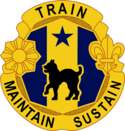| 81st Readiness Division, 81st Infantry Division 81st Army Reserve Command (81st ARCOM) 81st Regional Support Command (81st RSC) 81st Regional Readiness Command (81st RRC) 81st Readiness Division (81st RD) | |
|---|---|
 | |
| Active | 1917–1919 1921–1946 1967–present |
| Country | |
| Branch | |
| Type | Infantry 1917–1946 (Regular Army) Force Sustainment 1967–Present (Army Reserve) |
| Size | Division 1917–1946 Support Command 1967–Present |
| Nickname(s) | "Wildcat" (special designation)[2] |
| Motto(s) | "Wildcats never quit" |
| March | The Wildcat March |
| Mascot(s) | Sergeant Tuffy the Wildcat |
| Engagements | World War I
|
| Decorations | |
| Commanders | |
| Notable commanders | MG Charles Justin Bailey MG Paul J. Mueller |
| Insignia | |
| Distinctive unit insignia of the 81st ARCOM (1970–1996) and 81st RSC[3] |  |
The 81st Readiness Division ("Wildcat"[2]) was a formation of the United States Army originally organized as the 81st Infantry Division during World War I. After World War I, the 81st Division was allotted to the Organized Reserve as a "skeletonized" cadre division. In 1942, the division was reactivated and reorganized as the 81st Infantry Division and served in the Pacific during World War II. After World War II, the 81st Infantry Division was allotted to the Organized Reserve (known as the United States Army Reserve after 1952) as a Class C cadre division, and stationed at Atlanta, Georgia. The 81st Infantry Division saw no active service during the Cold War and was inactivated in 1965.[4]
In 1967 the division's shoulder sleeve insignia was reactivated for use by the 81st Army Reserve Command (81st ARCOM). From 1967 to 1995, the 81st ARCOM was headquartered in East Point, Georgia, commanded and controlled Army Reserve units in Georgia, South Carolina, Puerto Rico and portions of North Carolina, Florida and Alabama. During that time, the 81st ARCOM was responsible for deploying US Army Reserve units to Vietnam, Southwest Asia, and the Balkans. The 81st was relocated in 1996 to Birmingham, Alabama the first time the Wild Cats returned to Alabama. Since its moblization in 1942 at then Camp Rucker. Upon the relocation, the command was reorganized as the 81st Regional Support Command (RSC) and was responsible command and control of all Army Reserve units in the southeast United States and Puerto Rico.[1][5]
In 2003, the 81st RSC was reorganized as the 81st Regional Readiness Command (RRC), but retained essentially the same mission as its predecessor. In September 2008, the 81st RRC was inactivated at Birmingham, Alabama. In its place, a reorganized 81st Regional Support Command (RSC) was activated at Fort Jackson, South Carolina.[4] Unlike its predecessor units, the new 81st RSC had a fundamentally different mission. Gone was the responsibility for hundreds of Troop Program Units (TPU) units and Soldiers. Instead, the 81st RSC provided Base Operations (BASOPS) support to 497 Army Reserve units in nine southeastern states plus Puerto Rico and the US Virgin Islands. By providing essential customer care and services, the 81st RSC was intended to help the supported Operational, Functional and Training (OF&T) commands to focus on their core unit mission and ultimately meet force requirements for global combatant commanders.[6] In 2018, the 81st RSC was provisionally redesignated as the 81st Readiness Division, and designated to gain additional responsibilities from other Army Reserve Functional Commands in addition to the enduring BASOPS mission.
On 1 October 2018, the 81st RSC was officially reorganized as the 81st Readiness Division (USAR).[7]
- ^ a b 81st Regional Support Command, Shoulder Sleeve Insignia Archived 29 January 2017 at the Wayback Machine, United States Army Institute of Heraldry (TIOH), dated 17 September 2008, last accessed 31 May 2017
- ^ a b "Special Unit Designations". United States Army Center of Military History. 21 April 2010. Archived from the original on 9 July 2010. Retrieved 9 July 2010.
- ^ 81st Regional Support Command, Distinctive Unit Insignia Archived 29 January 2017 at the Wayback Machine, TIOH, dated 17 September 2008, last accessed 31 May 2017
- ^ a b "Lineage & Honors HQ 81st Regional Support Command". History. Army.Mil. Retrieved 29 January 2019.
- ^ 81st Regional Support Command US Army Reserve Official Website, last accessed 31 May 2017
- ^ Coker, Kathryn R. (2013). The Indispensable Force: The Post-Cold War Operational Army Reserve, 1990–2010. Fort Bragg, NC: Office of Army Reserve History. pp. 355–358.
- ^ Permanent Order F-008-001, Headquarters, United States Army Reserve Command (USARC), 8 January 2019.